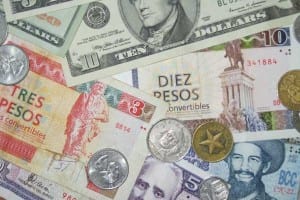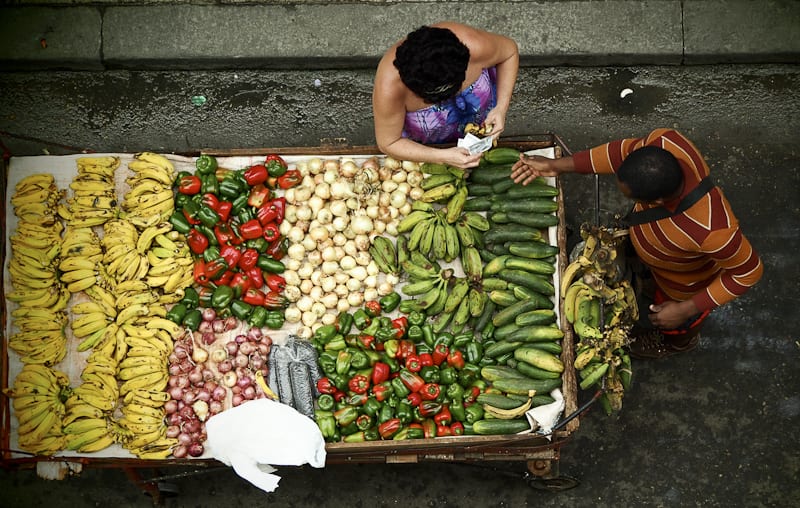Cuba’s Two Currencies Are Ideal for Fleecing Tourists
By Circles Robinson

HAVANA TIMES — The current tourist boom in Cuba accentuates the vulnerability of visitors to the the island’s two-currency system, which some have already read is a detriment to investment, efficiency and transparent bookkeeping.
On a recent trip I witnessed how the confusion between regular Cuban pesos (CUP) and the Convertible Peso (CUC) leads to the tourist being taken by the vendor or service provider.
One CUC exchanges for 24 CUP. To buy one CUC it costs 25 CUP. They are often both referred to as pesos.
I watched a tourist pay a vendor 1 CUC for a shot of coffee that costs 1 CUP and another pay 3 CUC for an ice cream cone that costs 3 CUP. Occasionally somebody in line notices that the vendor is taking the tourist for a ride and they speak out; however often they get away with it.
I have also seen incidents where the visitor asked the price of an item or service and is told 10 pesos and then pays with CUP, receiving a nasty reply from the provider leading to a heated discussion and finally having to fork out the CUC.
Here’s a few tips to not be exploited by the unscrupulous.

Go to a CADECA money exchange in the city and change a limited amount of your CUC’s into CUPs so that you have both.
(For reference, while the CUC is pegged to the dollar, a 10% surcharge + the commission means you will get 0.87 CUC for 1.00 USD.)
When trying to understand the correct price of something you see on the street when the sign just says 1.00 or 2.00 etc.:
– Ask someone else in line instead of the vendor and/or observe what other people are paying. Most people are honest and will explain. This is the best way to not make a mistake.
– Note if the price says CUP or the also used MN (Moneda Nacional) or CUC.
– Think logically of what the item would cost. For example a beer wouldn’t cost 2 pesos and must be 2 CUC, a collective taxi ride is 10 CUP not 10 CUC. Popcorn on the street makes much more sense at 5 CUP than 5 CUC. A pineapple might cost 10 or 15 pesos, not that amount in CUC.
– Many food establishments and stores now accept the two currencies interchangeable at the rate of 25 CUP to 1 CUC
– You can use 5 cents of a CUC interchangeably for 1 peso CUP. (You lose a little in the exchange)
– Keep your CUP and CUC separately in your purse or wallet to not confuse them which is easy to do.
If you have something to add to this list or a related personal experience to tell please do!


Dont forget about getting CUP bills or coins mixed in your change. A CUP coin or bill always has a person featured whereas a CUC coin or bill will feature a monument or building or scene.
Google “Cuban CUP vs CUC” images to see the difference
Good article Circles!
I would add this tip: Ask the price of a taxi ride before getting
in the vehicle, and make sure you know which currency you’re discussing.
Or don’t patronize a prison state because it has beaches. Frickin florida has beaches. Cuba is like the preachers daughter. Forbidden, and thus the source of its allure.
WHen you go you realize it’s a dump.
Yes, the 10% tax on cash US dollars remains in effect. The taking it off depended on the US allowing the Cuban government companies to have bank accounts in US dollars in the US. While this was promised by the Obama administration it never occurred.
Is the 10% tax still being applied to US dollar as of December 2016? An earlier article on this website from March 2016 announced that Cuba would be eliminating the tax.
To refer back to the headline of this article:
“Cuba’s two currencies are ideal for fleecing tourists”
I have in the past been involved at national level in the tourism industry. Our objective acting in conjunction with government and government agencies was to provide as much satisfaction as possible to the tourist and to encourage more. We were concerned to prevent or inhibit bad service or fleecing.
In Cuba, by far the greatest promoters and pursuers of fleecing are government agencies. For example, car hire where a CubaCar web site promised “VW or similar” and instead provides junky Geelys at a charge of US $65 par day PLUS a mandatory $18 per day insurance. It is also mandatory to purchase 93 octane gas at $1.15 per litre compared to 84 octane gas at $0.84 per litre. Read the small print in the contract carefully, because if the car receives as much as a scratch, a Police Report must be submitted if the $18 per day insurance is to pay.
The government controlled hotels in Havana have all bumped up their charges in anticipation of an increase in US tourists. There is no concern about retention of the existing tourists.The government Cadecas charge 3.5% for changing foreign currency into CUC and an additional charge for then changing the CUC into CUP (24 per CUC not 25).
CubaTaxi the government owned service charges at least three times the charges made by taxi-particular. (private taxis).
Until recently there was a charge of 25 CUC levied to leave Cuba.
It is not the private sector which preys, in Cuba it is the Castro regime that fleeces the tourists!
Yes, anybody can use CUP.
Lynch, one thing is deciding to give a big tip. Another is being grossly overcharged. Do you see the difference?
I did not mind giving $2 for a coffee. People in Cuba have little enough. If you are staying at an hotel, give your unwanted items, tips to people outside the hotel, groundstaff etc,.Be greatful that you can afford to give a few dollars to make someone happy. it means a lot
Thanks Circles, great explanation, Happy New Year as well.
So true about exchange for the Canadian dollar. We take enough money for tips, transportation etc but are buying fewer souvenirs than before. So yes the ordinary Cuban doesn’t benefit as much.
Good explanation Circles. For the uninitiated, the twin currency system was started by Fidel Castro. Over three years ago, Raul Castro announced that Cuba would revert to a single currency. A year ago the retail shops – which are operated by subsidiaries of GAESA the military holding company – started to accept CUP (pesos) in addition to Cuban convertibles (CUC). However the promised change to a single currency has yet to occur, probably because of fears of inflation.
By linking the Cuban currencies to the US dollar, Cuba has avoided its currency being affected by the market. However, that means for example that Canadian tourists to Cuba now get less than 3 CUC for 4 Canadian dollars. Similarly, Europeans (the euro) and the British (the pound) are paying relatively higher prices for everything they purchase when on vacation in Cuba. This is detrimental to the Cuban tourism industry. Another factor affecting non-American tourists to Cuba is that the regime has increased prices of many of its hotels in anticipation of a heavy flow of US tourists. That too will have a negative effect upon those from other countries.
Cubans also use the words “moneda nacional” to describe CUP transactions. An easy way to avoid confusion is to ALWAYS try to pay with CUP. If the currency necessitates CUC, the vendor won’t hesitate to let you know.